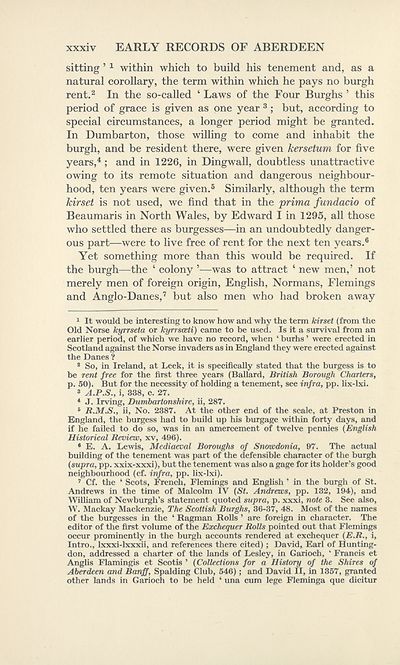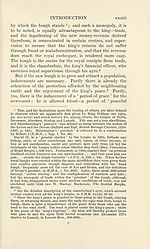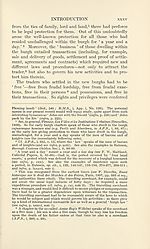Series 3 > Early records of the Burgh of Aberdeen
(39) Page xxxiv
Download files
Complete book:
Individual page:
Thumbnail gallery: Grid view | List view

xxxiv EARLY RECORDS OF ABERDEEN
sitting ’1 within which to build his tenement and, as a
natural corollary, the term within which he pays no burgh
rent.2 In the so-called ‘ Laws of the Four Burghs ’ this
period of grace is given as one year 3; but, according to
special circumstances, a longer period might be granted.
In Dumbarton, those willing to come and inhabit the
burgh, and be resident there, were given kersetum for five
years,4 ; and in 1226, in Dingwall, doubtless unattractive
owing to its remote situation and dangerous neighbour¬
hood, ten years were given.5 Similarly, although the term
kirset is not used, we find that in the prima fundacio of
Beaumaris in North Wales, by Edward I in 1295, all those
who settled there as burgesses—in an undoubtedly danger¬
ous part—were to live free of rent for the next ten years.6
Yet something more than this would be required. If
the burgh—the ‘ colony ’—was to attract ‘ new men,’ not
merely men of foreign origin, English, Normans, Flemings
and Anglo-Danes,7 but also men who had broken away
1 It would be interesting to know how and why the term kirset (from the
Old Norse kyrrseta or kyrrsceti) came to be used. Is it a survival from an
earlier period, of which we have no record, when ‘ burhs ’ were erected in
Scotland against the Norse invaders as in England they were erected against
the Danes ?
2 So, in Ireland, at Leek, it is specifically stated that the burgess is to
be rent free for the first three years (Ballard, British Borough Charters,
p. 50). But for the necessity of holding a tenement, see infra, pp. lix-lxi.
3 A.P.S., i, 338, c. 27.
4 J. Irving, Dumbartonshire, ii, 287.
6 R.M.S., ii. No. 2387. At the other end of the scale, at Preston in
England, the burgess had to build up his burgage within forty days, and
if he failed to do so, was in an amercement of twelve pennies (English
Historical Review, xv, 496).
* E. A. Lewis, Mediaeval Boroughs of Snowdonia, 97. The actual
building of the tenement was part of the defensible character of the burgh
(supra, pp. xxix-xxxi), but the tenement was also a gage for its holder’s good
neighbourhood (cf. infra, pp. lix-lxi).
7 Cf. the ‘ Scots, French, Flemings and English ’ in the burgh of St.
Andrews in the time of Malcolm IV (St. Andrews, pp. 132, 194), and
William of Newburgh’s statement quoted supra, p. xxxi, note 3. See also,
W. Mackay Mackenzie, The Scottish Burghs, 36-37, 48. Most of the names
of the burgesses in the ‘ Ragman Rolls ’ are foreign in character. The
editor of the first volume of the Exchequer Rolls pointed out that Flemings
occur prominently in the burgh accounts rendered at exchequer (E.R., i,
Intro., Ixxxi-lxxxii, and references there cited); David, Earl of Hunting¬
don, addressed a charter of the lands of Lesley, in Garioch, ‘ Francis et
Anglis Flamingis et Scotis ’ (Collections for a History of the Shires of
Aberdeen and Banff, Spalding Club, 546); and David II, in 1357, granted
other lands in Garioch to be held ‘ una cum lege Fleminga que dicitur
sitting ’1 within which to build his tenement and, as a
natural corollary, the term within which he pays no burgh
rent.2 In the so-called ‘ Laws of the Four Burghs ’ this
period of grace is given as one year 3; but, according to
special circumstances, a longer period might be granted.
In Dumbarton, those willing to come and inhabit the
burgh, and be resident there, were given kersetum for five
years,4 ; and in 1226, in Dingwall, doubtless unattractive
owing to its remote situation and dangerous neighbour¬
hood, ten years were given.5 Similarly, although the term
kirset is not used, we find that in the prima fundacio of
Beaumaris in North Wales, by Edward I in 1295, all those
who settled there as burgesses—in an undoubtedly danger¬
ous part—were to live free of rent for the next ten years.6
Yet something more than this would be required. If
the burgh—the ‘ colony ’—was to attract ‘ new men,’ not
merely men of foreign origin, English, Normans, Flemings
and Anglo-Danes,7 but also men who had broken away
1 It would be interesting to know how and why the term kirset (from the
Old Norse kyrrseta or kyrrsceti) came to be used. Is it a survival from an
earlier period, of which we have no record, when ‘ burhs ’ were erected in
Scotland against the Norse invaders as in England they were erected against
the Danes ?
2 So, in Ireland, at Leek, it is specifically stated that the burgess is to
be rent free for the first three years (Ballard, British Borough Charters,
p. 50). But for the necessity of holding a tenement, see infra, pp. lix-lxi.
3 A.P.S., i, 338, c. 27.
4 J. Irving, Dumbartonshire, ii, 287.
6 R.M.S., ii. No. 2387. At the other end of the scale, at Preston in
England, the burgess had to build up his burgage within forty days, and
if he failed to do so, was in an amercement of twelve pennies (English
Historical Review, xv, 496).
* E. A. Lewis, Mediaeval Boroughs of Snowdonia, 97. The actual
building of the tenement was part of the defensible character of the burgh
(supra, pp. xxix-xxxi), but the tenement was also a gage for its holder’s good
neighbourhood (cf. infra, pp. lix-lxi).
7 Cf. the ‘ Scots, French, Flemings and English ’ in the burgh of St.
Andrews in the time of Malcolm IV (St. Andrews, pp. 132, 194), and
William of Newburgh’s statement quoted supra, p. xxxi, note 3. See also,
W. Mackay Mackenzie, The Scottish Burghs, 36-37, 48. Most of the names
of the burgesses in the ‘ Ragman Rolls ’ are foreign in character. The
editor of the first volume of the Exchequer Rolls pointed out that Flemings
occur prominently in the burgh accounts rendered at exchequer (E.R., i,
Intro., Ixxxi-lxxxii, and references there cited); David, Earl of Hunting¬
don, addressed a charter of the lands of Lesley, in Garioch, ‘ Francis et
Anglis Flamingis et Scotis ’ (Collections for a History of the Shires of
Aberdeen and Banff, Spalding Club, 546); and David II, in 1357, granted
other lands in Garioch to be held ‘ una cum lege Fleminga que dicitur
Set display mode to:
![]() Universal Viewer |
Universal Viewer | ![]() Mirador |
Large image | Transcription
Mirador |
Large image | Transcription
Images and transcriptions on this page, including medium image downloads, may be used under the Creative Commons Attribution 4.0 International Licence unless otherwise stated. ![]()
| Scottish History Society volumes > Series 3 > Early records of the Burgh of Aberdeen > (39) Page xxxiv |
|---|
| Permanent URL | https://digital.nls.uk/126829791 |
|---|
| Attribution and copyright: |
|
|---|
| Description | Over 180 volumes, published by the Scottish History Society, containing original sources on Scotland's history and people. With a wide range of subjects, the books collectively cover all periods from the 12th to 20th centuries, and reflect changing trends in Scottish history. Sources are accompanied by scholarly interpretation, references and bibliographies. Volumes are usually published annually, and more digitised volumes will be added as they become available. |
|---|


